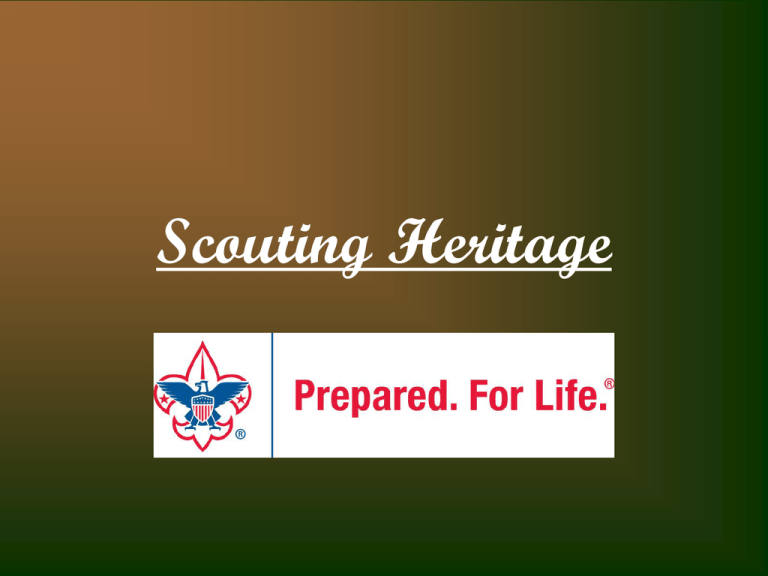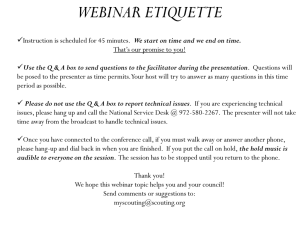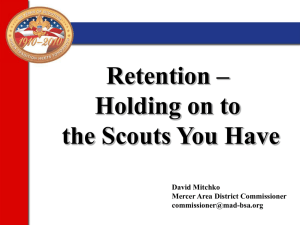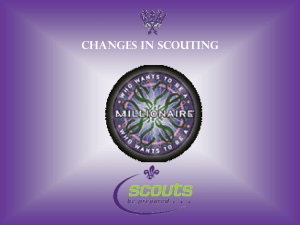it here
advertisement

Scouting Heritage Scouts who write or visit the National Scouting Museum receive this patch. This is the only way a Scout can authentically demonstrate that he has contacted or visited the Museum. Our Fathers A Victorian World 1837-1907 1845: Brunel built the S.S. Great Britain, the first propeller driven Steamship. 1867: Disraeli introduces a law giving voting rights to taxpayers. A year later he becomes Prime Minister. 1874: Within a year of his second term as Prime Minister, Disraeli purchases part of the Suez Canal. The British Empire begins gaining momentum. 1876: Queen Victoria is given the title “Empress of India”; a title that will hold until the reign of King George VI 1877: Telephone is made available for the first time, and Thomas Edison invents the Phonograph. 1879: The electric light bulb is invented by Thomas Edison. 1885: Karl Benz invents the first gasoline powered automobile 1888: Jack the Ripper terrorizes London Developments of Scouting in England 1857: Robert Stephenson Smyth Powell is Born. 1876: Leaves school to join the Army. 1899: The Boer War is officially declared in October . 1899: Baden-Powell Publishes Aides to Scouting 1907: Trial campout at Brownsea; the Boy Scout movement is born. 1908: Scouting for Boys is published. 1909: Scouting is started in almost the entire British Empire and the origins of the Boy Scouts of America. 1910: Sea Scouts is officially created. Austria, Bermuda, Denmark, Finland, France, Greece, Jamaica, Kenya, Netherlands, Singapore, United States, and Zimbabwe officially charter Boy Scout programs. B-P visits North America; consents to the creation of the Girl Guide program but does not recognize Girl Scouts. 1914: World War 1 starts, the British mobilize Scouts to take over the role of the Coast Guard. Wolf Scouts and Brownie Guides are started. 1916: Wolf Cub book is published. Lady BP is named Commissioner of Girl Guides. America: First Decade of the th 20 Century 1903 First Flight at Kitty Hawk First Message to Travel Around the World First Silent Movie, The Great Train Robbery First World Series First License Plates Issued in the U.S. 1904 New York City Subway Opens 1907 First Electric Washing Machine 1908 Ford Introduces the Model-T SOS Accepted as Universal Distress Signal 1909 Plastic Is Invented 1906 Kellogg's Starts Selling Corn Flakes Upton Sinclair Writes The Jungle Ernest Thompson Seton • Born: August 14, 1860 in South Shield, Durham, England. • Artist, Naturalist, Story-Teller, First Chief Scout of the Boy Scouts of America • Founder of the Woodcraft Indians in 1902 and wrote the Birch Bark Roll of the Outdoor Life in 1906. • In 1906 Seton met with Lord Robert Baden- Powell during a trip to England. • Along with Daniel Carter Beard’s Sons of Daniel Boone, and other youth movements and his own Woodcraft Indians, the Boy Scouts of America were founded in 1910. • Seton served from 1910-1915 as a member of the National Council of the Boy Scouts of America as the Chief Scout. – He was also the Chairman of the Founding Committee of the BSA. • Seton was a supporter of Cub Scouts and argued for the adoption of the program. • Seton died in 1946. Daniel Carter Beard • Born: 1850 in Cincinnati, Ohio. • Illustrator, author, youth leader, and social reformer. • Founder of the Sons of Daniel Boone. • Was named one of the first National Commissioners of the BSA in 1910; he served for 30 years. • With Ernest Thompson Seton, their work is considered the foundation of Traditional Scouting. • Seton became President of the Camp Fire Club of America for his efforts in securing a Federal Charter for the Camp Fire Girls. • Considered the founder of the oldest and longest continuously chartered troop by the Boy Scouts of America. Troop 1 in Flushing, NY. • Influential in the development of Boy’s Life Magazine. • Illustrator for two books by Mark Twain: Connecticut Yankee in King Arthur’s Court and Tom Sawyer: Abroad • He died in 1941. Photo Provided by National Scouting Museum Archivist Steven Price James E. West • Born: May 16, 1876 in Washington D.C. • A lawyer by trade, West was also a children’s rights advocate. • Became the first Chief Scout Executive of the Boy Scouts of America in 1911 and retired in 1943. • West pushed for a the BSA to receive a Federal Charter, which eventually came in 1916. • Disagreed with Seton about the need for a Cub program. • Sought to the downplaying of the more militaristic parts of Scouting. • James West died in 1948. Photo Provided by National Scouting Museum Archivist Steven Price Brownsea Island • Brownsea Island is located off the coast of Dorset, England. History of inhabitants of the Island go back as early as the 9th Century A.D. • It was on Brownsea Island in the first week of August, 1907 that Lord Robert Baden-Powell took a group of young men to Brownsea for an experiment. • Brownsea Island offered the greatest chance for Powell to put his theories of scouting for men to the test with boys. • Following the success of the week long expedition, Lord Robert Baden-Powell published Scouting for Boys in 1908. Brownsea Island Scout Camp Daily Program The daily program was as follows: • 6:00 a.m. Turn out, air bedding, milk and biscuits • 6:30 a.m. Exercises • 7:00 a.m. Notices of day´s activities with demonstrations • 7:30 a.m. Clean camp • 7:55 a.m. Parade • Flag break followed by Prayers • Breakfast • 9:00 a.m. Scouting practices • 12 noon Bathing • 12:30 p.m. Lunch • • • • • • • • • • • 1-2:15 p.m. Rest 2:30 p.m. Scouting practices 5:00 p.m. Tea 6:00 p.m. Camp games 7:15 p.m. Rub down and change 8:00 p.m. Supper 8:15 p.m. Campfire yarns. Short exercises ( breathing, etc.) 9:15 p.m. Prayers 9:30 p.m. Turn in Lights out. Scout Camp Daily Program Lord Robert Baden-Powell used the Koodoo horn (captured in Matabeland in 1896) to rouse the camp and for signals; several shorts notes meant "Rally"; a long call meant "Ready". This horn was sounded by Lord Baden-Powell at the opening of the Coming of Age Jamboree in 1929. Boy Scout Handbook • In 1908 Lord Robert Baden-Powell published Scouting For Boys, a follow up for young boys interested in his book Aides to Scouting For Non-Commissioned Officers and Men. The book held information regarding citizenship, outdoor fun, and physical fitness. • The Boy Scout Handbook is an important part of all Boy Scouting programs all over the world. • In America, the BSA originally published the Original Edition in 1910. This book was intended as a temporary handbook for Boys. • Since 1911, the BSA has published the Official Handbook for Boys. • In it Scouts can find information regarding rank advancement, outdoor activities, citizenship, and all other Scouting activities. • The Boy Scout Handbook is the guide for all Scouts. Photo Provided by National Scouting Museum Archivist Steven Price Boy Scout Handbook • The Third Edition of the Handbook is published between 1927-1940. It is the first handbook with a cover designed by Norman Rockwell. It is the first major content revision. • The Fifth Edition is published between 1949-1959. Contains new advancement requirements as well as a new joining age of 11. It introduces Scouts to lashings and the taut line hitch. • The Sixth Edition was published bewteen 1959-1965. Written by William “Green Bar Bill” Hillcourt. The first handbook to contain no merit badge requirements. And is the only cover with a painting by Norman Rockwell specifically designed for a handbook. • The Eighth Edition of the Handbook was published bewteen 1972-1979. It contained a newly revamped Boy Scouting Program that contained “skill awards” similar to the belt loops earned by Cub Scouts. It is the first handbook with a cover painted by Joseph Csatari. • The Ninth Edition, 1979-1990, was also written by Hillcourt. It featured a return to traditional Scouting skills. • The Tenth Edition, published bewteen 1990-1998, was the first to feature color photographs and introduced Scouts to low-impact camping. • The Eleventh Edition, published between 1998 and 2009 introduces GPS to Scouting. Cub Scouting • • • • • • • With the guidance of his friend Rudyard Kipling’s children’s book The Jungle Book, Lord Baden-Powell developed Cubbing in 1907 for younger boys. In America, Ernest Thompson Seton proposed the addition of a Cub program before his departure from the Boy Scouts in 1915. The first American Cub Scout packs were chartered beginning in 1930 with approximately 8,000 boys. The original program was simply called “Cubbing” and was later changed to Cub Scouts of America. Cub Scouts offers a program for boys 6-10 years old that helps them prepare for entering the Boy Scout program. Scouts earn the ranks of Bobcat, Tiger, Wolf, Bear and Webelos before going on to earn their Arrow of Light and bridging into Boy Scouts. Cub Scouts is not a mandatory step to becoming a Boy Scout. Cub Scouts must earn their Bobcat badge, but are not required to finish any other rank before they are allowed to bridge into Boy Scouts. Photo Provided by National Scouting Museum Archivist Steven Price Cub Scouting • 4/1/1911: Boy Scout of America officially set the age to join Scouting at 12. – Junior Troops began to be formed unofficially. • 1916: Wolf Cubbing is officially adopted in England. • 1918: the first Wolf Cub Pack is established in Montana – 1920: a Wolf Cub Pack is established in Paris, Texas. • Both James West and Dan Beard opposed the creation of a younger boy program. • 1918: West took out a copyright for the British Wolf Cub’s Handbook. This book is sold for 10 years by the National Supply Group. • 1927: American Cub Scouting officially receives support. Ernest Thompson Seton contributes to the development. • 1938: Bobcat Pin is introduced, only to be worn on civilian clothes. • 1940’s: – Webelos Rank is introduced for Cub Scouts age 11 ½ who had earned Lion and completed several requirements for Tenderfoot. – Cubbing renamed Cub Scouts – 1948 Den Mothers required to be registered. – 1949: membership age dropped to 8. Boy Scouts and Explorers follow suit. – Long Trousers are introduced as a part of the uniform in 1947. Cub Scouting • 1950’s: – Webelos den for 10 year olds officially introduced. – 1954: Wolf, Bear & Lion books revised. – 1954: Pinewood Derby introduced. • 1960’s: – 2.7 million Cub Scouts at the start of 1960, 1.8 by years end. 30% drop. – Webelos overhauled in 1967. – Grade level, rather than age, is introduced for membership in Cub Scouting (3rd grade.) 1967. – Space Derby introduced. • 1970’s: – Emphasis on scouts with disabilities. • 60,000 youths with disabilities enroll special units. 150,000 others join main stream units. • 1978: Age limit for the disabled are lifted, allowing individuals to continue working past the age cut off. – Cub Scout Promise is changed. – Advancement program revised to focus on outdoor activities and family camping. – Day Camp Schools start in 1975. – Role of women in Scouting expanded in 1975. Cub Scouting • 1980’s: – Golden Anniversary of Cub Scouts. – 30 Millionth Cub Scout registered. – Tiger Cub Scouts started. • 1990’s: – Academics were added to the Sports program. – 1991:The Guide to Safe Scouting introduced in – 1995: Tiger Cub program revised. – 1996: Crime Prevention Program introduced. – Garfield becomes official spokescat for the Cub Scouts. • 2000’s: – First Tiger Cub handbook introduced. – Tiger Badge introduced. – All Cub Scout handbooks are revised. – August 2004: Hispanic Youth initiative started. Boy Scouting -1905: Daniel Carter Beard forms the Son’s of Daniel Boone, an organization that will be influential in the forming of the BSA. -1906: Ernest Thompson Seton published the Birchbark Roll of Woodcraft for his Woodcraft Indians. He sends a copy to Lord B.P, which will be influential in his writing of Scouting for Boys. -1910: The Boy Scouts of America is officially incorporated in New York on February 8th; the first headquarters is at 3 Park Ave., New York City, New York. Seton is named Chief Scout, Beard becomes the first National Commissioner, West is named Chief Scout Executive and President Theodore Roosevelt is named Chief Scout Citizen. - The Founding mission is, “to teach [boys] patriotism, courage, self-reliance, and kindred values.” -The BSA issues the Handbook of Woodcraft, Scouting, and Life-craft written by Ernest Thompson Seton and contains much of B.P’s Scouting for Boys. -14 merit badges are included in the first edition including Ambulance,Clerk,Cyclist, Electrician, Fireman, Gardener, Horseman, Marksman, Master-of-Arms, Musician, Pioneer Seaman, Signaler , and Stalker. -The first National Good Turn is introduced. -The Scout Handbook contains the ranks of Tenderfoot, Second class and First Class; a Scout who earns all 14 of the Merit Badges is awarded the Silver Wolf. Boy Scouting: The Early Years • 1910- Boy Scouts of America is officially incorporated. • 1911- Boy Scouts of America establish permanent headquarters in New York City. – The first award for Heroism is presented by the National Court of Honor. – The eagle appears on the BSA fleur de lis to make it more American. • 1913- BSA provides charters for councils and divides the country into districts. – A Scout is given the honor of reading the Gettysburg Address at the 50th Anniversary celebration of the Battle of Gettysburg. • 1914- The first Hornaday medal is awarded. • 1915- The BSA begins publishing merit badge pamphlets. • 1916- June 15, Congress gives the Boy Scouts of America a Federal Charter. • 1940- Irving Berlin established the God Bless American Foundation, which provides proceeds from the sale of his song God Bless America to the Boy Scouts and Girl Scouts of America. • 1949- Following the Cub Scout Division, Boy Scouting changes the minimum age requirement to 11. Eagle Scout A History • In the June 1911 Handbook for Boys, the highest honor a Scout could earn was the Silver Wolf Scout. • Taken directly from the British model, Silver Wolf Scout was changed to Eagle Scout by August 1911. • Arthur Eldred became the first Eagle Scout in August 1912 after earning 21 merit badges by April 1912. He was one of 23 Scouts to earn Eagle in 1912. • Since the first Eagle was awarded, over 2 million boys have attained the rank. • Originally, Eagle Scout was awarded to any First Class scout to earn twenty-one merit badges. Life and Star required 5 each and Eagle required 11. Star and Life were reversed in 1925 to their present order: Star, Life and Eagle. • In 1927 service was added to Star, Life and Eagle. To earn Eagle you had to be a First Class for a year. By the early 30’s that requirement changed to 3 months as a First Class, 3 months as a Star and 6 months as a Life Scout. • In 1948 a Life Scout had to show service by participating as a leader in his troop’s meetings, outdoor activities and projects. • By 1965 Scouts had to participate in Scoutmaster Conferences. Star and Life Scouts had to plan and execute two service projects (a conservation and community service project.) Eagle Scout required you to do just one, but a far more extensive project. • Eagle Palms were created in 1927 to satisfy those who wanted to create ranks beyond Eagle Scout. • Eagle Scout holds the distinction as one of a few civilian honors to be worn on a military uniform. Scouting History Photos Photos Provided by National Scouting Museum Archivist Steven Price Scouting History Photos Photo Provided by National Scouting Museum Archivist Steven Price Lone Scouting • Lone Scouting was begun in 1915 by William D. Boyce. • Boyce was troubled by the fact boys on farms and in the country could not participate in Scouting. • Using his own money, Boyce created the Lone Scouts of America. • In 1924, Boyce merged the LSA with the BSA. • In the 1930’s the BSA fully integrated the Lone Scout program. • Today there exists the Lone Scouts and the Lone Cub Scouts. • In Lone Scouting, Scouts are able to participate fully in Scouting while not being a member of a traditional Pack or Troop. • It is one of only two programs where a boy can participate in Boy Scouting while not serving in a Troop. • Today, Lone Scouting has a membership only in the 100’s. Varsity Scouting • Founded in 1984, Varsity was developed to allow boys aged 14-18 interested in sports and high adventure to continue working on Boy Scout rank through special Varsity units. • The program faced a number of challenges, which among other things saw the development of Varsity Patrols and Venturing Patrols within Troops to address older boy interests in Sports and High Adventure. • Today, the Varsity Scouting program is devoted almost entirely to the interest in Sports. Unlike it’s other Senior Scouting brother programs, Varsity is for boys only. • Varsity Scouting offers Scouts an alternative to the traditional Troop structure, while still allowing Scouts to work on rank advancement. Varsity Scouting • The Varsity Scout Handbook was first published in 1984. • In the book a Varsity Scout can find information on the Uniform, Organization, Leadership Positions, Fields of Emphasis, and how to be a model Varisty Scout. • The Uniform differs from the Boy Scout Uniform in only a handful of ways. – They wear Orange Epilates. – Originally they also wore brown pants. • The Organization and Leadership of a Varisty Team is similar to that of a Troop. – Captain – Co-Captain – Program Managers – Squad Leaders – Secretary – Quartermaster – Treasurer • Originally, Varsity was established to provide younger boys who were not old enough to join an Explorer Post a chance to participate in High Adventure. • In addition, Varsity allows scouts to continue working on Boy Scout ranks, which Venturing does not. • In addition to High Adventure, Varsity focuses on Sports as a major part of their program. Today most Teams are sport oriented. Exploring/Venturing • 1912: Sea Scouting is begun in the United States. It is the first older boy program established by the BSA. – 1928- Sea Scout Paul Siple journeys to Antarctica with Admiral Byrd. • 1933: BSA introduces Explorer Scouts, a land based version of Sea Scouts. • 1935: Senior Scouting Service is introduced; it overseas Sea and Explorer Scouts as well as early alumni organizations like Alpha Phi Omega. • 1942: Air Scouting is introduced; it is disbanded in 1954. • 1949: Explorers is formed out of a combination between Explorer Scouts and Senior Scouting. Any boy registered with the BSA and at least 14 is called an Explorer. • 1959: After a University of Michigan study revealed boys 14-16 were less interested in advancement and adopting changes to the Explorer program, the BSA introduced the Exploring program. • 1969: Modern Exploring is born after yet another study found that boys were interested in learning more about career opportunities. – Girls are permitted to participate in Exploring. • 1971: Girls are given full membership in the Exploring Scouting program. – It remains the only fully co-educational program within the BSA. • 1998: Venturing is formed out of the Exploring program. – Venturing encompasses the Hobby and High Adventure aspects of Exploring while the career oriented program moved under Learning for Life. Exploring/Venturing • Venturing units allow young adults ages 14-21 to explore high adventure and hobbies in specially created units. For those who are interested, Venturing allows Scouts to work on rank advancement on their way to earning the Silver Award. • Venturers are prohibited from earning Boy Scout rank and awards unless a registered member of a Boy Scout Troop. • Venturing has a distinct leadership structure from Scouting. – Venturing uses more generic club terms such as President, Vice President and Secretary. • Girls make up around half of the total membership in Venturing. • Venturers are permitted to attend the National High Adventure bases at Philmont, Northern Tier and Sea Base. • In preparation for the 2019 World Jamboree set to be held at the Summit, Venturers were allowed to attend the National Jamboree for the first time. – In the past they were allowed to volunteer to work the Jamboree but were not allowed to attend it as participants. Learning for Life Exploring • In 1998 the Boy Scouts of America announced that the Exploring Division was being renamed Venturing and that the career interest Exploring program was being removed from the BSA to it’s subsidiary Learning For Life. • The largest career interest Exploring program is Police Exploring although there are other career interest fields covered by the LFL programs including Fire, EMS, et al. • For more information about the Career Exploring program please visit: http://exploring.learningforlife.org/ Order of the Arrow • The Order of the Arrow was founded in 1915 but did not receive official BSA sanction until 1948. • Founded by E. Urner Goodman in 1915, the Order of the Arrow focuses around Native American traditions and legends in an effort to help Scouts become better campers. • Through it’s three stages (Ordeal, Brotherhood and Honor Vigil) Scouts and select Scouters learn how to give back to Scouting and their community through camp related service. • Only registered Boy Scouts (and leaders) are allowed membership. • The Order of the Arrow is the Boy Scouts of America most prolific community service organization. Photo Provided by National Scouting Museum Archivist Steven Price Created by Joe Connole National Scouting Museum • Resources: – Ernest Thompson Seton: http://www.etsetoninstitute.org/BIOBYDEE.HTM – Lone Scouts: http://www.sossi.org/lonescout/lshistory.htm – Boy Scout Timeline: http://www.virtualscoutmuseum.com/ – Brownsea: http://www.thescoutingpages.org.uk/first_camp.html – Cub Scouting- Special thanks to Burts Kennedy for supplying information about the evolution of Cub Scouts. – Exploring/Venturing/Learning for LIfe- Thanks to Bill Taylor in Learning for Life for supplying the History of Exploring.




